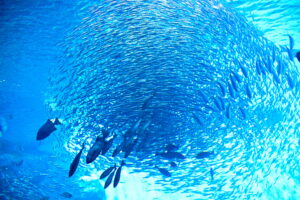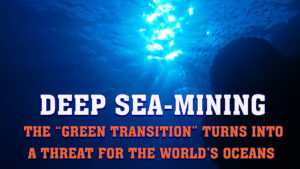Life in the oceans presents itself to us in immense diversity and breathtaking beauty. This vast, life-giving, self-sustaining and self-renewing habitat has always drawn us human beings into its powerful spell and fills us with wonder. With admiration, we recognise that we are part of something far greater that forms the basis of our existence. Let us take this awareness and appreciation of our connectedness as a starting point to better understand and protect the oceans.
Did you know, for example, that…
 sardines organise themselves into schools in a magical way without needing a ‘conductor’? Millions of sardines – comparable to the population of a large city – swim in perfect synchronicity and move like one single creature without ever colliding, simply by adapting to the currents they create. When a predator approaches, the swarm splits into two groups to confuse the attacker. The sardine swarm has various strategies for capturing its food, plankton: either it abandons its formation so that each sardine can feed individually, or it swims in an orderly row towards its prey and devours it with systematic efficiency. Even if the swarm is several kilometres long, each individual sardine fits purposefully into the overall plan of the swarm.
sardines organise themselves into schools in a magical way without needing a ‘conductor’? Millions of sardines – comparable to the population of a large city – swim in perfect synchronicity and move like one single creature without ever colliding, simply by adapting to the currents they create. When a predator approaches, the swarm splits into two groups to confuse the attacker. The sardine swarm has various strategies for capturing its food, plankton: either it abandons its formation so that each sardine can feed individually, or it swims in an orderly row towards its prey and devours it with systematic efficiency. Even if the swarm is several kilometres long, each individual sardine fits purposefully into the overall plan of the swarm. the Hawaiian dwarf octopus forms a symbiotic relationship with luminous bacteria that live in its light organ? The oxygen-rich environment in this organ allows these bacteria to produce light, which the octopus uses to camouflage itself from predators during its night-time hunt by adapting its appearance to the moonlight using a technique called ‘counter-illumination’. In return for producing light, the bacteria receive nutrients and a protected habitat. This relationship is so close that the young octopuses absorb the bacteria from their environment immediately after hatching, thus starting the symbiosis.
the Hawaiian dwarf octopus forms a symbiotic relationship with luminous bacteria that live in its light organ? The oxygen-rich environment in this organ allows these bacteria to produce light, which the octopus uses to camouflage itself from predators during its night-time hunt by adapting its appearance to the moonlight using a technique called ‘counter-illumination’. In return for producing light, the bacteria receive nutrients and a protected habitat. This relationship is so close that the young octopuses absorb the bacteria from their environment immediately after hatching, thus starting the symbiosis. the tuna probably has the most efficient respiratory system and blood circulation in the entire animal kingdom? He needs this to be able to swim without stopping. He has nowhere to take shelter and sleeps while swimming, as he can only breathe while moving. This is because his gills only work when they are constantly flushed with water. And the tuna obtains this by eating incessantly. Its favourite food includes shoals of sardines and anchovies, mackerel, krill and even jellyfish. This predatory fish can consume as much food as it weighs in one day. By the way, a little hint for all beach holiday fans: the tuna population is a significant factor in terms of jellyfish regulation on the coasts.
the tuna probably has the most efficient respiratory system and blood circulation in the entire animal kingdom? He needs this to be able to swim without stopping. He has nowhere to take shelter and sleeps while swimming, as he can only breathe while moving. This is because his gills only work when they are constantly flushed with water. And the tuna obtains this by eating incessantly. Its favourite food includes shoals of sardines and anchovies, mackerel, krill and even jellyfish. This predatory fish can consume as much food as it weighs in one day. By the way, a little hint for all beach holiday fans: the tuna population is a significant factor in terms of jellyfish regulation on the coasts.
The oceans are an inexhaustible source of inspiration that man can use as guidance for an orderly, harmonious and life-sustaining coexistence. And not only in the oceans, but in the whole of nature and all creation, everything is connected to everything else. The sooner we realise that only through interdependence all life is at all possible, the sooner we will come together to form the unity that our planet so urgently needs in order to provide us all – from the smallest to the largest living being – with its abundant life on a permanent basis.









